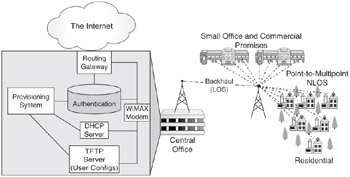WiMAX
Worldwide Interoperability for Microwave Access (WiMAX) is based on the IEEE 802.16 suite of specifications for wireless metropolitan area networks and seeks to provide very high bandwidth wireless access over significant distances. The earlier WiMAX specifications aimed to provide wireless broadband services to fixed and nomadic users, but the newer 802.16e specification also caters to the mobile broadband market. The expectation is that WiMAX will provide wireless broadband access to residential and commercial subscribers so as to offer competition to existing wireline DSL and cable providers since WiMAX currently provides specifications for operating in both the licensed and unlicensed frequency spectrums and can be deployed in point-to-point, point-to-multipoint, and fully mobile configurations.
While WiMAX will offer good coverage at high bandwidths to multiple users, the general deployment model will be similar to that used in other wireless networks, both cellular and WiFi. In this configuration, a series of base stations will be connected to a central hub, some kind of base station controller, and a series of base station controllers will be connected to some central infrastructure that will include the following:
-
Authentication authorization and accounting (AAA) functions
-
Local access configuration information such as IP address, DNS server address, access domain name, and default gateway address
-
External routing functions providing access to the Internet, access to the PSTN, and other services infrastructure
A device end-point in WiMAX is referred to as a Subscriber Station (SS), and when it is manufactured it is provided with a 48-bit Ethernet MAC address, a manufacturer-issued and installed X.509 certificate and the X.509 certificate of the manufacturer. The SS uses these certificates and the 48-bit MAC address when registering with the network. Unlike an IMSI, MSISDN, or MIN, a manufacturer's X.509 certificate and device MAC address do not provide any indication as to the identity of a connecting device's home network. Without this identification, it is difficult to implement a network that will support user roaming while providing the access supplier with a mechanism for charging, and ensuring that the end-device has access to the services that they are paying for. WiMAX deployments today are largely point-to-point and point-to-multipoint installations designed to provide a competitive alternative to wired broadband offerings. Access providers provision authentication systems with the public key and MAC address of each end-point. These are then used to identify and authenticate a connecting end-point. Consequently, roaming support is not a significant factor at this point in time. With the advent of 802.16e and fully mobile WiMAX, higher-layer authentication schemes and network identifiers, such as those using NAI with fully qualified user-names, will become necessary.
The configuration shown in Figure 8.9 is similar to the Cable configuration described in Chapter 6. A central provider provides access to a group of subscriber installations, each of whom have to have their MAC address and physical location provisioned into the central office authentication system before a network connection can be established. In this model, a centralized LIS can be provisioned and accessed in very much the same way as the Cable or DSL network LIS can.

Figure 8.9: WiMAX as a wired broadband alternative.
Where the SS can be nomadic or even mobile then other techniques for location determination beyond direct provisioning need to be employed. In previous sections, we have described some of the techniques available to other wireless technologies including timing and signal strength mechanisms and assisted GPS (A-GPS). Most of these will be applicable to WiMAX in some form though they may require modification to address the encoding schemes used in WiMAX communication. For example, the symbol period for a digital encoding scheme is often used to provide timing advance information, where the distance between each subsequent timing advance increment is directly proportional to the symbol period. However, encoding schemes used in WiMAX have long symbol periods, so using conventional TA techniques will result in large errors. Adapting TA algorithms to operate with WiMAX OFDM encoding techniques may improve the accuracy of these location techniques. There is little doubt that a combination of network and device-based measurements will be required to provide accurate location information for mobile WiMAX subscriber stations the same as they are for cellular mobile devices today. The exchange of measurement information will require a negotiation of capabilities between the end-point and access network; the LIS and mechanisms to support this capabilities exchange are described in Chapter 9.
EAN: 2147483647
Pages: 129